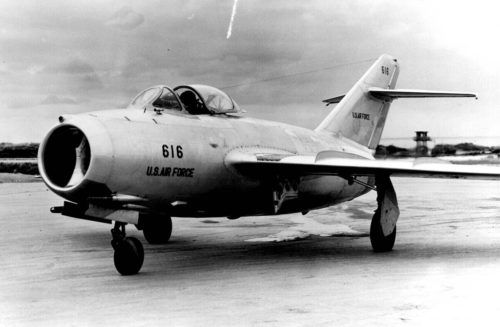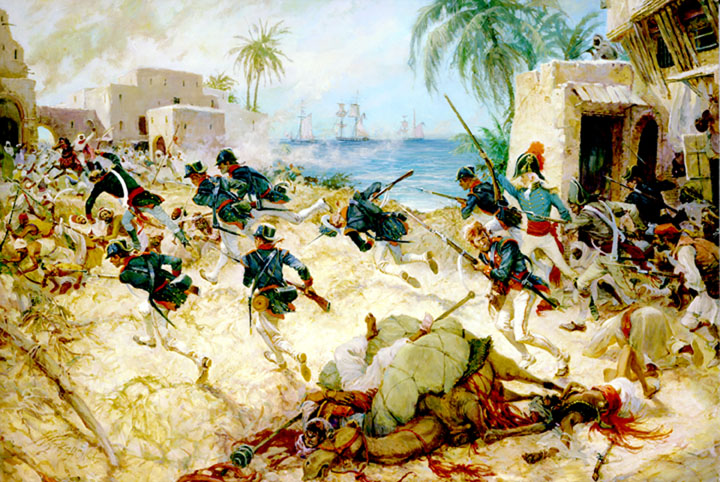April 27 in U.S. military history
Featured image: “… to the shores of Tripoli…” Lt. Presley O’Bannon leading Marines during the Battle of Derna, inspiring the famous opening line to the Marine Corps Hymn. (painting by Col. Charles Waterhouse, USMC art collection)
1805: Following an extremely difficult march across a 500-to-700-mile stretch of North African desert, a force of eight U.S. Marines, two Navy midshipmen, and band of Arab and Greek mercenaries commanded by U.S. Army officer William Eaton have reached the fortress at Derna (modern-day Libya) during the First Barbary War.
Supported by three warships (USS Nautilus, USS Hornet, and USS Argus), Eaton personally leads the two-and-a-half-hour assault on the fortress. One Marine is killed in action and another mortally wounded in the first U.S. land battle on foreign soil. The Battle of Derna also marks the first time the U.S. flag is raised over foreign soil.
Legend states that newly installed, pro-American pasha Hamet Karamanli was so impressed with Marine 1st Lt. Presley O’Bannon’s leadership and heroics that he presents O’Bannon with a Mameluke sword. U.S. Marine officers today still carry the Mameluke sword, whereas Marine NCOs carry the traditional Naval infantry saber.
1813: Brig. Gen. Zebulon Pike’s 1,800-man American infantry force lands west of the Canadian town of York (present-day Toronto). Supported by a 14-ship naval flotilla, the Americans inflict heavy losses on the outnumbered British regulars, Canadian militia, and Ojibwe warriors. The fort’s magazine explodes during the battle, killing 38 Americans (including Pike) and wounding over 200. York is burned after the town’s capture, enraging the British and inspiring them to retaliate by burning Washington, D.C. the next year.
1865: The overcrowded Mississippi River steamboat Sultana, carrying 2,400 Union soldiers just released from Confederate prison, explodes and sinks just north of Memphis. At least 1,500 soldiers perish in the greatest maritime disaster in U.S. history.
1953: As armistice negotiations begin, Gen. Mark Clark – the commander of UN forces in Korea – informs Communist pilots through shortwave radio broadcasts in Russian, Chinese, and Korean that defecting MiG-15 pilots would receive political asylum and $50,000 (the first defecting pilot would be awarded $100,000) to fly an operational jet to South Korea. The Russian MiG-15 was considered to be superior to any Allied fighter at the time and had inflicted heavy casualties on Allied airmen.

Although no pilot would take up the offer until September, Operation MOOLAH had the indirect effect of grounding MiG-15 sorties for several days – perhaps as Communist Party leaders investigated the loyalty of their pilots. And following Clark’s broadcasts, there would be no more sightings of Russian pilots or aircraft, which were considerably better pilots than their Chinese or North Korean MiG counterparts.
1972: After an astounding 871 unsuccessful strike missions against North Vietnam’s Thanh Hoa Bridge, F-4 Phantoms armed with Paveway I laser-guided bombs finally knock out the stubborn bridge, which had become a symbol of communist resistance against the United States.
